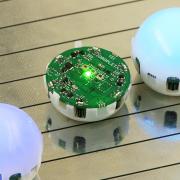
University of Colorado Boulder Assistant Professor Nikolaus Correll likes to think in multiples.
If one robot can accomplish a singular task, think how much more could be accomplished if you had hundreds of them.
Correll and his computer science research team, including research associate Dustin Reishus and professional research assistant Nick Farrow, have developed a basic robotic building block, which he hopes to reproduce in large quantities to develop increasingly complex systems.
Recently the team created a swarm of 20 robots, each the size of a pingpong ball, which they call “droplets.” When the droplets swarm together, Correll said, they form a “liquid that thinks.”
To accelerate the pace of innovation, he has created a lab where students can explore and develop new applications of robotics with basic, inexpensive tools.
Similar to the fictional “nanomorphs” depicted in the “Terminator” films, large swarms of intelligent robotic devices could be used for a range of tasks. Swarms of robots could be unleashed to contain an oil spill or to self-assemble into a piece of hardware after being launched separately into space, Correll said.
Correll plans to use the droplets to demonstrate self-assembly and swarm-intelligent behaviors such as pattern recognition, sensor-based motion and adaptive shape change. These behaviors could then be transferred to large swarms for water- or air-based tasks.
Correll hopes to create a design methodology for aggregating the droplets into more complex behaviors such as assembling parts of a large space telescope or an aircraft.
via University of Colorado at Boulder
The Latest Streaming News: Swarm robots updated minute-by-minute
Bookmark this page and come back often
Latest NEWS
Latest VIDEO







